

Compact Muon Solenoid
LHC, CERN
| CMS-PAS-B2G-17-017 | ||
| Search for resonant $\mathrm{t\bar{t}}$ production in proton-proton collisions at $\sqrt{s}= $ 13 TeV | ||
| CMS Collaboration | ||
| June 2018 | ||
| Abstract: A search for a heavy resonance decaying into top quark and antiquark ($\mathrm{t\bar{t}}$) pairs is performed using proton-proton collisions at $\sqrt{s}= $ 13 TeV. The search uses the full data set collected with the CMS detector in 2016, which corresponds to an integrated luminosity of 36 fb$^{-1}$. The analysis is split into three exclusive final states and uses reconstruction techniques that are optimized for top quarks with high Lorentz boosts, which requires the use of nonisolated leptons and jet substructure techniques. No significant excess of events relative to the expected yield from standard model processes is observed. Upper limits on the production cross section of heavy resonances decaying to $\mathrm{t\bar{t}}$ are calculated. Limits are derived for a leptophobic topcolor Z' resonance with widths of 1%, 10%, and 30% relative to the mass of the resonance. Additional exclusion limits are set for a Kaluza-Klein (KK) excitation of the gluon in the Randall-Sundrum model and a model where a narrow Z' resonance is exclusively produced in association with jets. To date, these are the most stringent limits on a $\mathrm{t\bar{t}}$ resonance. | ||
|
Links:
CDS record (PDF) ;
CADI line (restricted) ;
These preliminary results are superseded in this paper, JHEP 04 (2019) 031. The superseded preliminary plots can be found here. |
||
| Figures | |

png pdf |
Figure 1:
The invariant mass distributions for 4 different signal models at 3 (left) and 5 (right) TeV. |

png pdf |
Figure 1-a:
The invariant mass distributions for 4 different signal models at 3 (left) and 5 (right) TeV. |
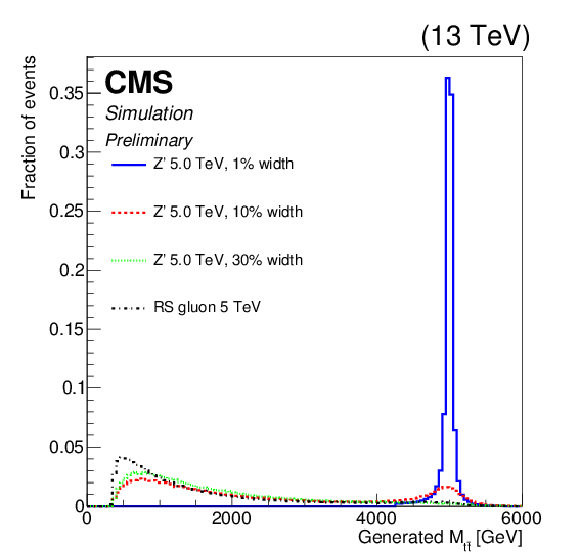
png pdf |
Figure 1-b:
The invariant mass distributions for 4 different signal models at 3 (left) and 5 (right) TeV. |

png pdf |
Figure 2:
Distributions of $\Delta R_{\text {sum}}$ before the fit to data in $\mu \mu $ (left), $ {\mathrm {e}} {\mathrm {e}}$ (middle) and $ {\mathrm {e}}\mu $ (right) events. The hashed band on the simulation represents the statistical and pre-fit systematic uncertainties. |
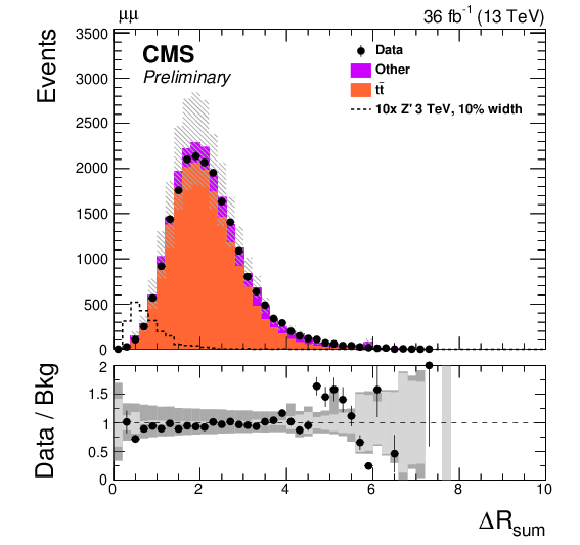
png pdf |
Figure 2-a:
Distributions of $\Delta R_{\text {sum}}$ before the fit to data in $\mu \mu $ (left), $ {\mathrm {e}} {\mathrm {e}}$ (middle) and $ {\mathrm {e}}\mu $ (right) events. The hashed band on the simulation represents the statistical and pre-fit systematic uncertainties. |
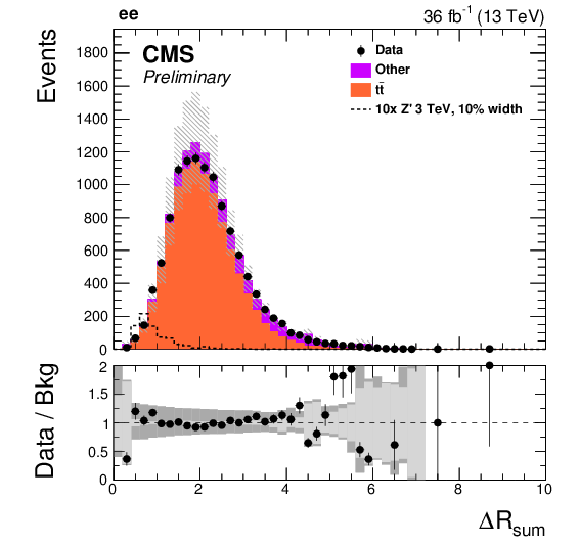
png pdf |
Figure 2-b:
Distributions of $\Delta R_{\text {sum}}$ before the fit to data in $\mu \mu $ (left), $ {\mathrm {e}} {\mathrm {e}}$ (middle) and $ {\mathrm {e}}\mu $ (right) events. The hashed band on the simulation represents the statistical and pre-fit systematic uncertainties. |

png pdf |
Figure 2-c:
Distributions of $\Delta R_{\text {sum}}$ before the fit to data in $\mu \mu $ (left), $ {\mathrm {e}} {\mathrm {e}}$ (middle) and $ {\mathrm {e}}\mu $ (right) events. The hashed band on the simulation represents the statistical and pre-fit systematic uncertainties. |
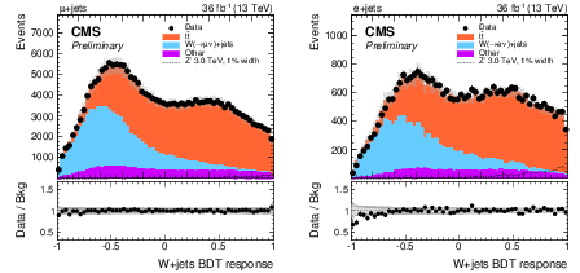
png pdf |
Figure 3:
W+jets BDT distributions in the muon (left) and electron (right) single lepton channel. The signal region is defined as events with $ {{\mathrm {W}}}\text {+jets BDT} \ge 0.5$. The hashed band on the simulation represents the post-fit uncertainties. |
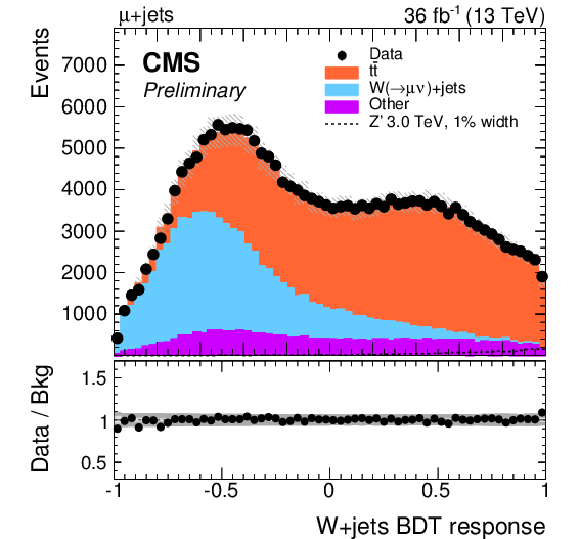
png pdf |
Figure 3-a:
W+jets BDT distributions in the muon (left) and electron (right) single lepton channel. The signal region is defined as events with $ {{\mathrm {W}}}\text {+jets BDT} \ge 0.5$. The hashed band on the simulation represents the post-fit uncertainties. |
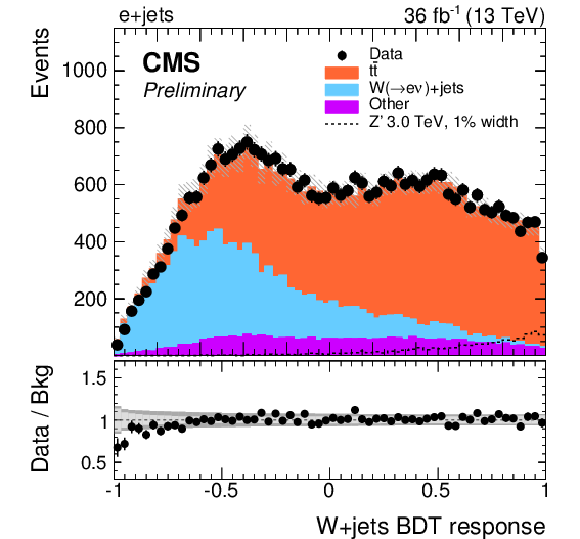
png pdf |
Figure 3-b:
W+jets BDT distributions in the muon (left) and electron (right) single lepton channel. The signal region is defined as events with $ {{\mathrm {W}}}\text {+jets BDT} \ge 0.5$. The hashed band on the simulation represents the post-fit uncertainties. |
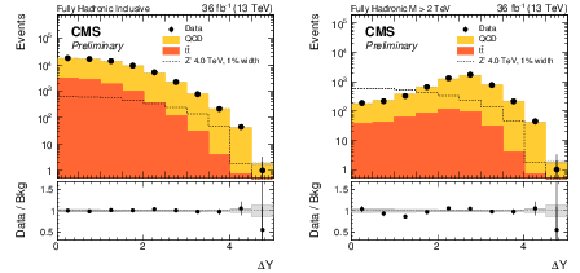
png pdf |
Figure 4:
Dijet rapidity difference for events passing the fully hadronic event selection: (left) $\Delta $Y (inclusive in $ {M_{{{\mathrm {t}\overline {\mathrm {t}}}}}} $), (right) $\Delta $Y $({M_{{{\mathrm {t}\overline {\mathrm {t}}}}}} > $ 2 TeV). The hashed band on the simulation represents the post-fit uncertainties. |
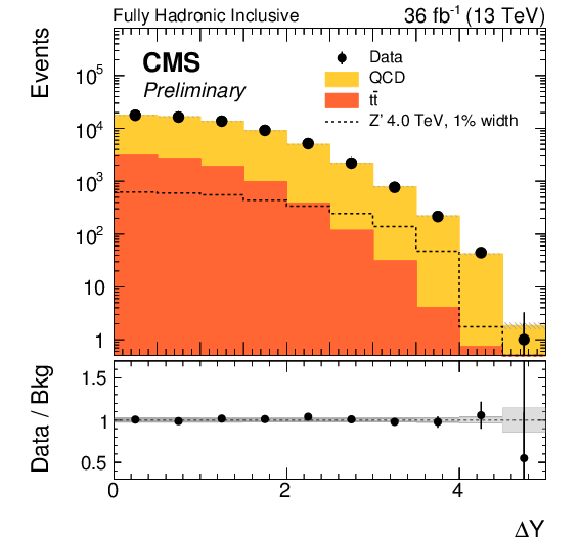
png pdf |
Figure 4-a:
Dijet rapidity difference for events passing the fully hadronic event selection: (left) $\Delta $Y (inclusive in $ {M_{{{\mathrm {t}\overline {\mathrm {t}}}}}} $), (right) $\Delta $Y $({M_{{{\mathrm {t}\overline {\mathrm {t}}}}}} > $ 2 TeV). The hashed band on the simulation represents the post-fit uncertainties. |

png pdf |
Figure 4-b:
Dijet rapidity difference for events passing the fully hadronic event selection: (left) $\Delta $Y (inclusive in $ {M_{{{\mathrm {t}\overline {\mathrm {t}}}}}} $), (right) $\Delta $Y $({M_{{{\mathrm {t}\overline {\mathrm {t}}}}}} > $ 2 TeV). The hashed band on the simulation represents the post-fit uncertainties. |

png pdf |
Figure 5:
Distributions of the $ {S_{\text {T}}} $ variable in the background-enriched control sample for $\mu \mu $ (left), $ {\mathrm {e}} {\mathrm {e}}$ (middle) and $ {\mathrm {e}}\mu $ (right) sub-channels. The hashed band on the simulation represents the post-fit uncertainties. |
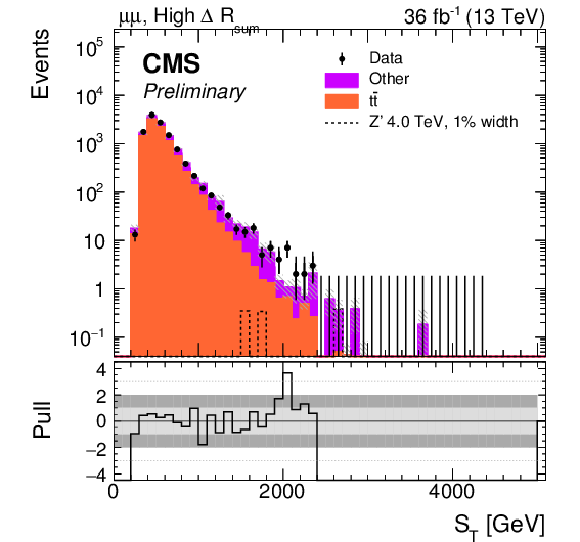
png pdf |
Figure 5-a:
Distributions of the $ {S_{\text {T}}} $ variable in the background-enriched control sample for $\mu \mu $ (left), $ {\mathrm {e}} {\mathrm {e}}$ (middle) and $ {\mathrm {e}}\mu $ (right) sub-channels. The hashed band on the simulation represents the post-fit uncertainties. |
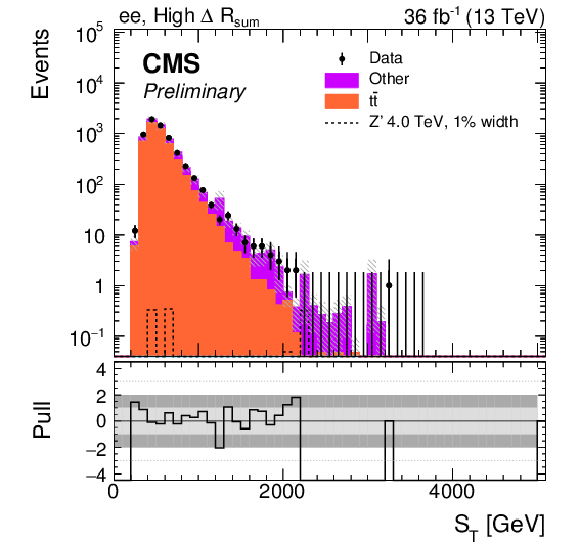
png pdf |
Figure 5-b:
Distributions of the $ {S_{\text {T}}} $ variable in the background-enriched control sample for $\mu \mu $ (left), $ {\mathrm {e}} {\mathrm {e}}$ (middle) and $ {\mathrm {e}}\mu $ (right) sub-channels. The hashed band on the simulation represents the post-fit uncertainties. |

png pdf |
Figure 5-c:
Distributions of the $ {S_{\text {T}}} $ variable in the background-enriched control sample for $\mu \mu $ (left), $ {\mathrm {e}} {\mathrm {e}}$ (middle) and $ {\mathrm {e}}\mu $ (right) sub-channels. The hashed band on the simulation represents the post-fit uncertainties. |
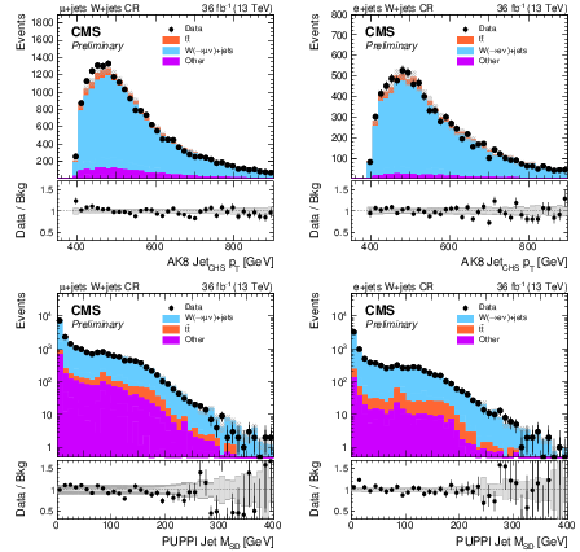
png pdf |
Figure 6:
Distributions of the $ {p_{\mathrm {T}}} $ and $M_{\text {SD}}$ for the W+jets background in the muon (left) and electron (right) channels. The hashed band on the simulation represents the post-fit uncertainties. |
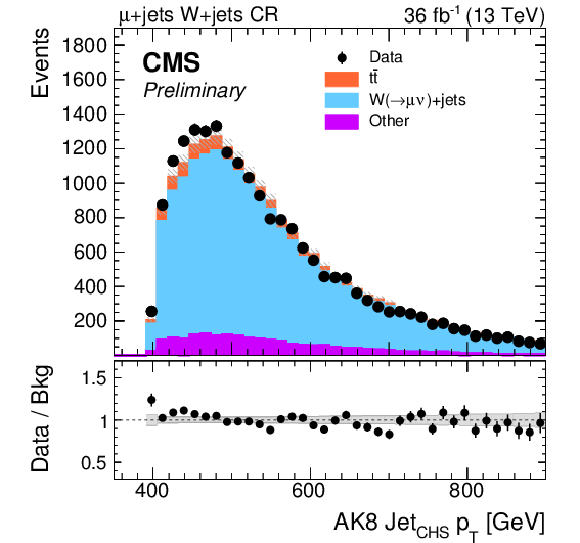
png pdf |
Figure 6-a:
Distributions of the $ {p_{\mathrm {T}}} $ and $M_{\text {SD}}$ for the W+jets background in the muon (left) and electron (right) channels. The hashed band on the simulation represents the post-fit uncertainties. |

png pdf |
Figure 6-b:
Distributions of the $ {p_{\mathrm {T}}} $ and $M_{\text {SD}}$ for the W+jets background in the muon (left) and electron (right) channels. The hashed band on the simulation represents the post-fit uncertainties. |

png pdf |
Figure 6-c:
Distributions of the $ {p_{\mathrm {T}}} $ and $M_{\text {SD}}$ for the W+jets background in the muon (left) and electron (right) channels. The hashed band on the simulation represents the post-fit uncertainties. |

png pdf |
Figure 6-d:
Distributions of the $ {p_{\mathrm {T}}} $ and $M_{\text {SD}}$ for the W+jets background in the muon (left) and electron (right) channels. The hashed band on the simulation represents the post-fit uncertainties. |
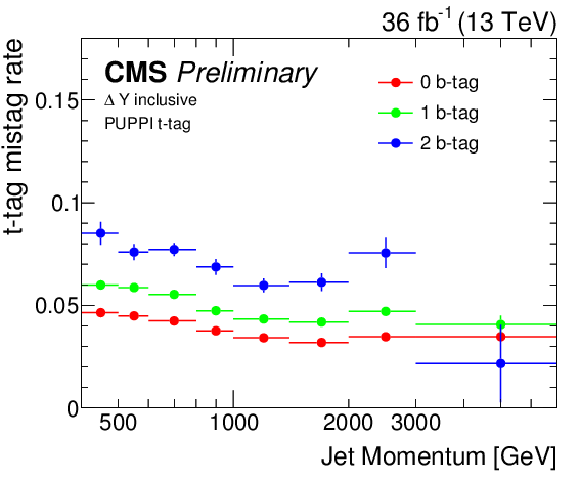
png pdf |
Figure 7:
t-tagging mistag rate as measured with an anti-tag and probe procedure separately for each b-tagged category. |

png pdf |
Figure 8:
Distributions of $ {S_{\text {T}}} $ for the $\mu \mu $ (top), $ {\mathrm {e}} {\mathrm {e}}$ (middle), and $ {\mathrm {e}}\mu $ (bottom) signal regions in the boosted (left) and non-boosted (right) regions. The hashed band on the simulation represents the post-fit uncertainties. |

png pdf |
Figure 8-a:
Distributions of $ {S_{\text {T}}} $ for the $\mu \mu $ (top), $ {\mathrm {e}} {\mathrm {e}}$ (middle), and $ {\mathrm {e}}\mu $ (bottom) signal regions in the boosted (left) and non-boosted (right) regions. The hashed band on the simulation represents the post-fit uncertainties. |

png pdf |
Figure 8-b:
Distributions of $ {S_{\text {T}}} $ for the $\mu \mu $ (top), $ {\mathrm {e}} {\mathrm {e}}$ (middle), and $ {\mathrm {e}}\mu $ (bottom) signal regions in the boosted (left) and non-boosted (right) regions. The hashed band on the simulation represents the post-fit uncertainties. |

png pdf |
Figure 8-c:
Distributions of $ {S_{\text {T}}} $ for the $\mu \mu $ (top), $ {\mathrm {e}} {\mathrm {e}}$ (middle), and $ {\mathrm {e}}\mu $ (bottom) signal regions in the boosted (left) and non-boosted (right) regions. The hashed band on the simulation represents the post-fit uncertainties. |
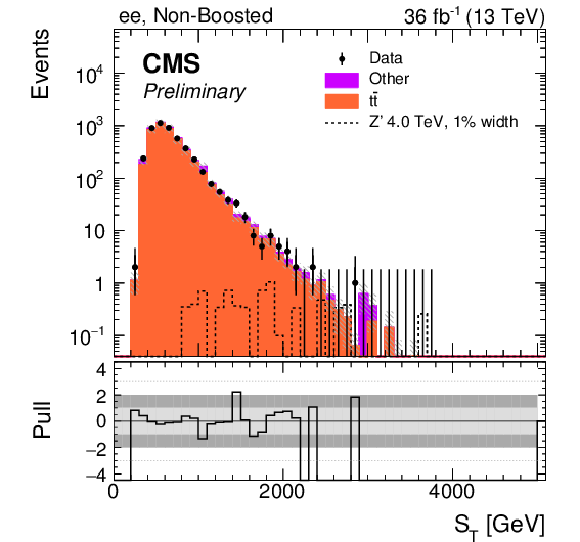
png pdf |
Figure 8-d:
Distributions of $ {S_{\text {T}}} $ for the $\mu \mu $ (top), $ {\mathrm {e}} {\mathrm {e}}$ (middle), and $ {\mathrm {e}}\mu $ (bottom) signal regions in the boosted (left) and non-boosted (right) regions. The hashed band on the simulation represents the post-fit uncertainties. |
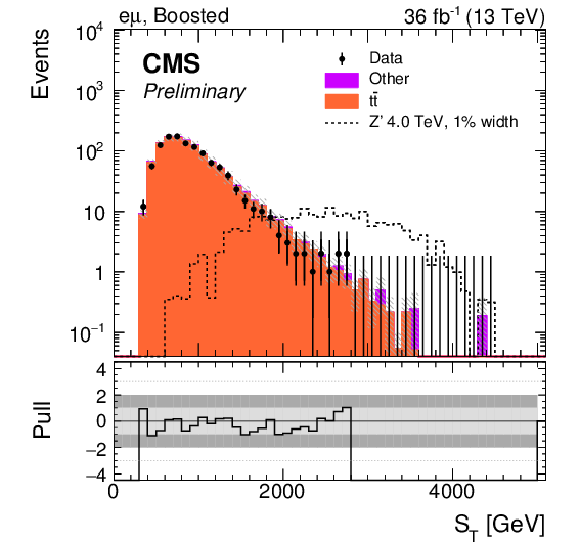
png pdf |
Figure 8-e:
Distributions of $ {S_{\text {T}}} $ for the $\mu \mu $ (top), $ {\mathrm {e}} {\mathrm {e}}$ (middle), and $ {\mathrm {e}}\mu $ (bottom) signal regions in the boosted (left) and non-boosted (right) regions. The hashed band on the simulation represents the post-fit uncertainties. |

png pdf |
Figure 8-f:
Distributions of $ {S_{\text {T}}} $ for the $\mu \mu $ (top), $ {\mathrm {e}} {\mathrm {e}}$ (middle), and $ {\mathrm {e}}\mu $ (bottom) signal regions in the boosted (left) and non-boosted (right) regions. The hashed band on the simulation represents the post-fit uncertainties. |

png pdf |
Figure 9:
Distributions of $ {M_{{{\mathrm {t}\overline {\mathrm {t}}}}}} $ for the single lepton channel signal regions for the muon (left) and electron (right) categories with (top) and without (bottom) t-tagging. The hashed band on the simulation represents the post-fit uncertainties. |
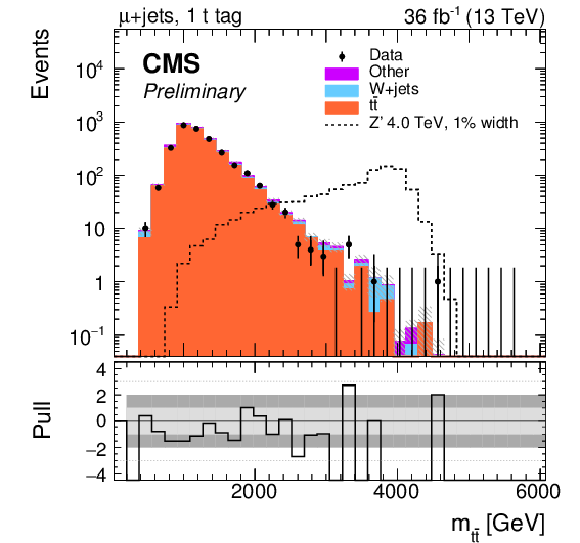
png pdf |
Figure 9-a:
Distributions of $ {M_{{{\mathrm {t}\overline {\mathrm {t}}}}}} $ for the single lepton channel signal regions for the muon (left) and electron (right) categories with (top) and without (bottom) t-tagging. The hashed band on the simulation represents the post-fit uncertainties. |

png pdf |
Figure 9-b:
Distributions of $ {M_{{{\mathrm {t}\overline {\mathrm {t}}}}}} $ for the single lepton channel signal regions for the muon (left) and electron (right) categories with (top) and without (bottom) t-tagging. The hashed band on the simulation represents the post-fit uncertainties. |
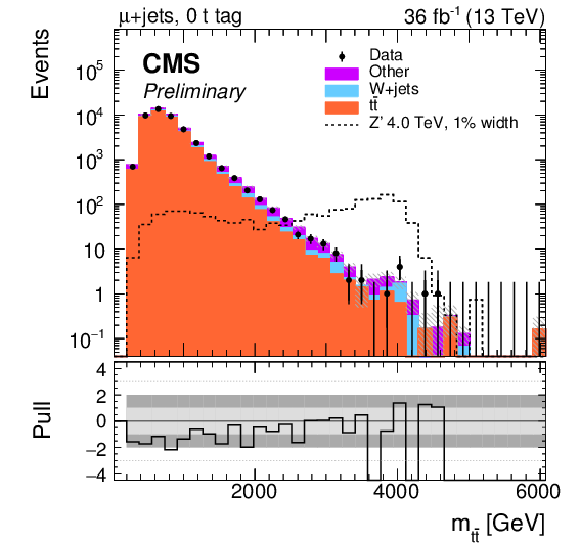
png pdf |
Figure 9-c:
Distributions of $ {M_{{{\mathrm {t}\overline {\mathrm {t}}}}}} $ for the single lepton channel signal regions for the muon (left) and electron (right) categories with (top) and without (bottom) t-tagging. The hashed band on the simulation represents the post-fit uncertainties. |

png pdf |
Figure 9-d:
Distributions of $ {M_{{{\mathrm {t}\overline {\mathrm {t}}}}}} $ for the single lepton channel signal regions for the muon (left) and electron (right) categories with (top) and without (bottom) t-tagging. The hashed band on the simulation represents the post-fit uncertainties. |
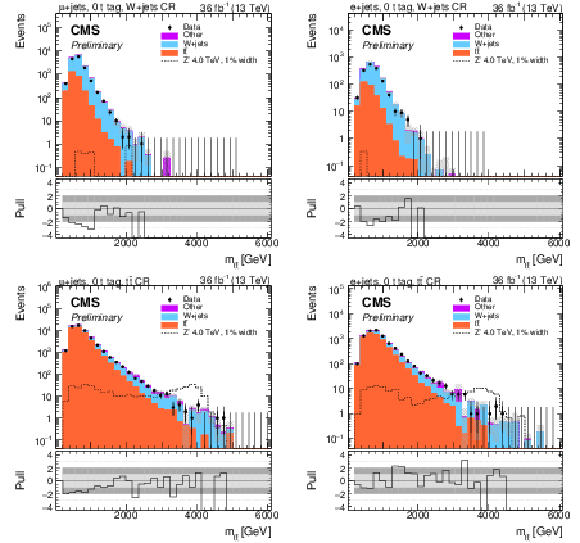
png pdf |
Figure 10:
Distributions of $ {M_{{{\mathrm {t}\overline {\mathrm {t}}}}}} $ for the single lepton channel control regions for the muon (left) and electron (right) categories that are light (top) and heavy (bottom) flavor enriched. The hashed band on the simulation represents the post-fit uncertainties. |

png pdf |
Figure 10-a:
Distributions of $ {M_{{{\mathrm {t}\overline {\mathrm {t}}}}}} $ for the single lepton channel control regions for the muon (left) and electron (right) categories that are light (top) and heavy (bottom) flavor enriched. The hashed band on the simulation represents the post-fit uncertainties. |
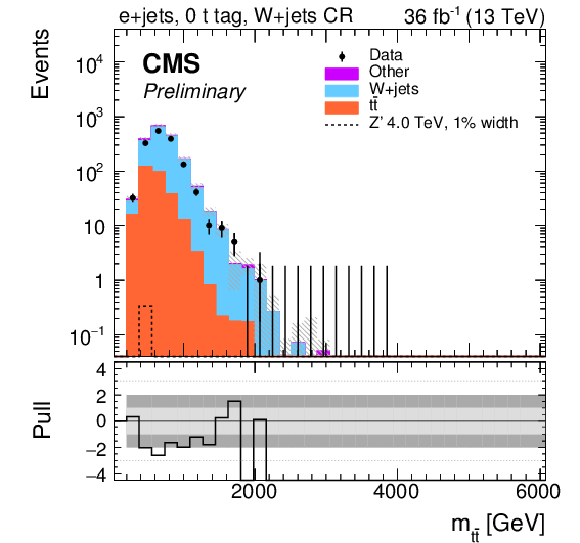
png pdf |
Figure 10-b:
Distributions of $ {M_{{{\mathrm {t}\overline {\mathrm {t}}}}}} $ for the single lepton channel control regions for the muon (left) and electron (right) categories that are light (top) and heavy (bottom) flavor enriched. The hashed band on the simulation represents the post-fit uncertainties. |

png pdf |
Figure 10-c:
Distributions of $ {M_{{{\mathrm {t}\overline {\mathrm {t}}}}}} $ for the single lepton channel control regions for the muon (left) and electron (right) categories that are light (top) and heavy (bottom) flavor enriched. The hashed band on the simulation represents the post-fit uncertainties. |

png pdf |
Figure 10-d:
Distributions of $ {M_{{{\mathrm {t}\overline {\mathrm {t}}}}}} $ for the single lepton channel control regions for the muon (left) and electron (right) categories that are light (top) and heavy (bottom) flavor enriched. The hashed band on the simulation represents the post-fit uncertainties. |

png pdf |
Figure 11:
Distributions of $ {M_{{{\mathrm {t}\overline {\mathrm {t}}}}}} $ for the fully hadronic channel signal region categories, used to extract the final results. The hashed band on the simulation represents the post-fit uncertainties. |

png pdf |
Figure 11-a:
Distributions of $ {M_{{{\mathrm {t}\overline {\mathrm {t}}}}}} $ for the fully hadronic channel signal region categories, used to extract the final results. The hashed band on the simulation represents the post-fit uncertainties. |
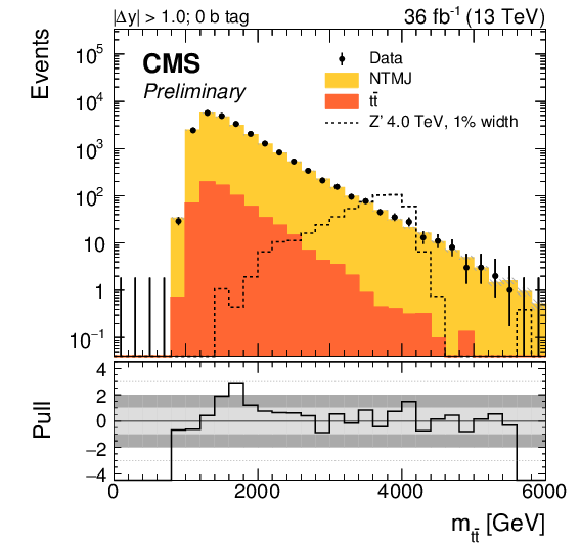
png pdf |
Figure 11-b:
Distributions of $ {M_{{{\mathrm {t}\overline {\mathrm {t}}}}}} $ for the fully hadronic channel signal region categories, used to extract the final results. The hashed band on the simulation represents the post-fit uncertainties. |
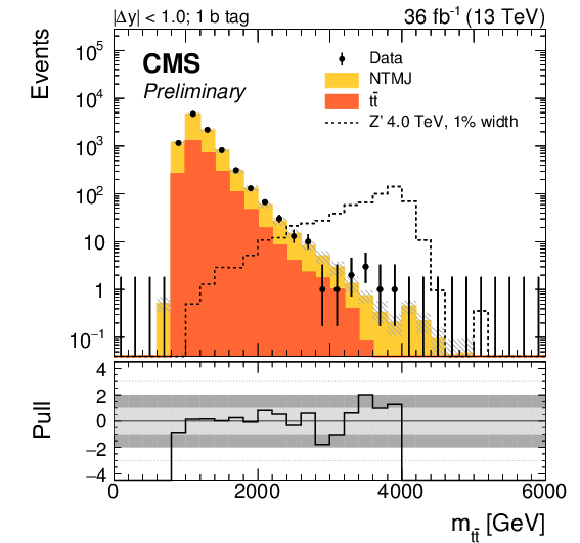
png pdf |
Figure 11-c:
Distributions of $ {M_{{{\mathrm {t}\overline {\mathrm {t}}}}}} $ for the fully hadronic channel signal region categories, used to extract the final results. The hashed band on the simulation represents the post-fit uncertainties. |
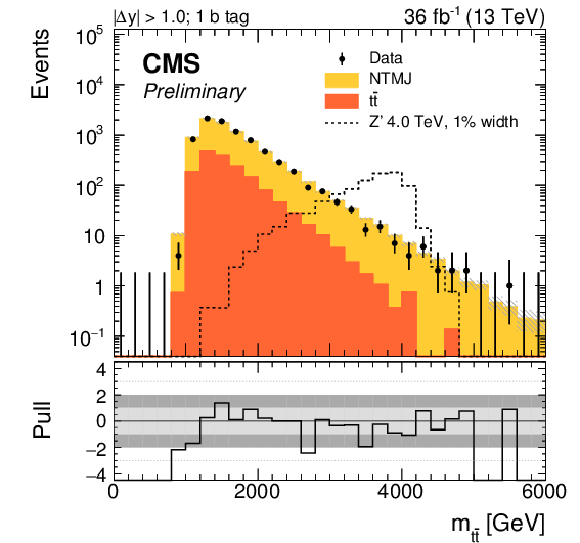
png pdf |
Figure 11-d:
Distributions of $ {M_{{{\mathrm {t}\overline {\mathrm {t}}}}}} $ for the fully hadronic channel signal region categories, used to extract the final results. The hashed band on the simulation represents the post-fit uncertainties. |
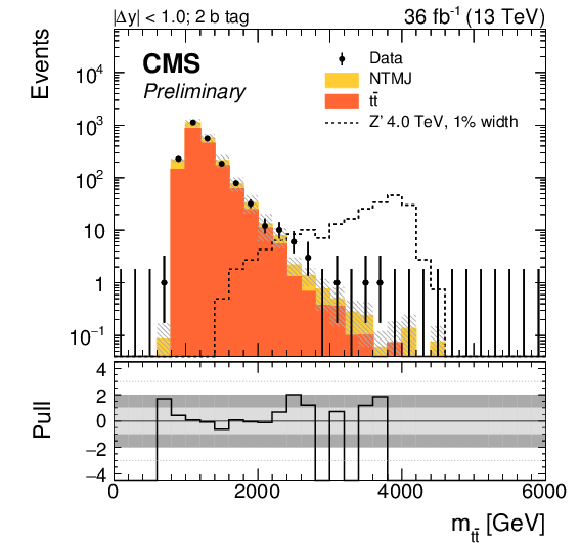
png pdf |
Figure 11-e:
Distributions of $ {M_{{{\mathrm {t}\overline {\mathrm {t}}}}}} $ for the fully hadronic channel signal region categories, used to extract the final results. The hashed band on the simulation represents the post-fit uncertainties. |
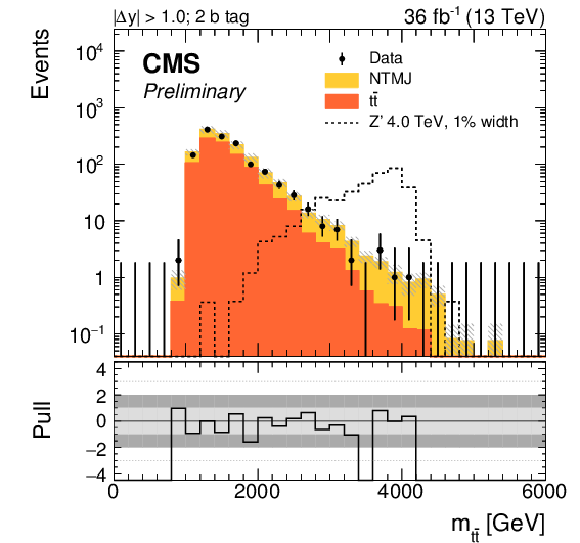
png pdf |
Figure 11-f:
Distributions of $ {M_{{{\mathrm {t}\overline {\mathrm {t}}}}}} $ for the fully hadronic channel signal region categories, used to extract the final results. The hashed band on the simulation represents the post-fit uncertainties. |
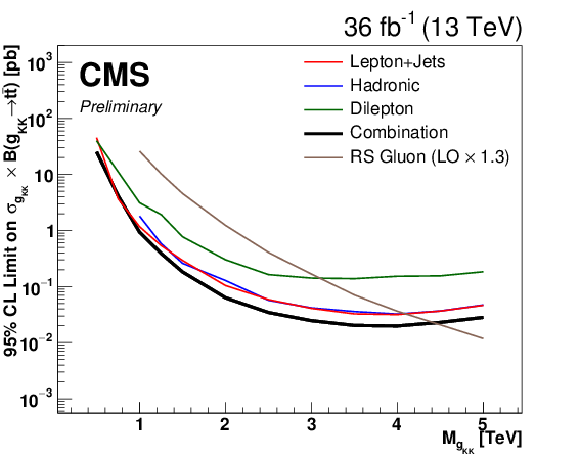
png pdf |
Figure 12:
Comparison of sensitivities for each analysis channel contributing to the combination. The expected limits are shown for each channel in the colored lines, while the combination result is shown in the black line. These results are shown specifically for the $ {g_{\text {KK}}} $ signal hypothesis as this model has characteristics that are common to many $ {{\mathrm {t}\overline {\mathrm {t}}}} $ resonance searches. |
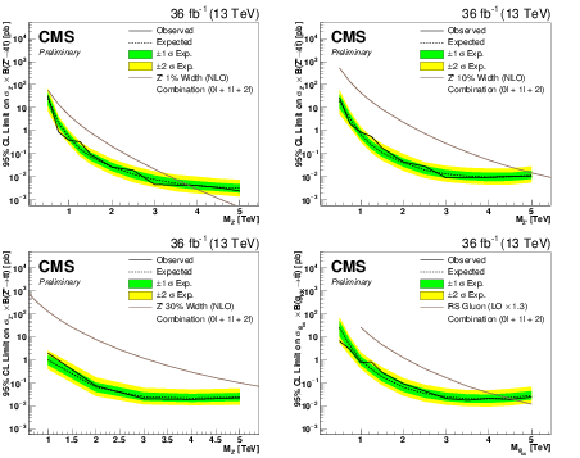
png pdf |
Figure 13:
Observed and expected limits for each of the four signal hypotheses considered in this analysis. |
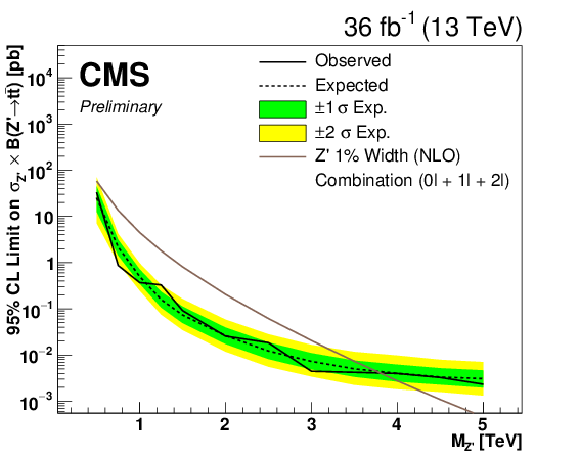
png pdf |
Figure 13-a:
Observed and expected limits for each of the four signal hypotheses considered in this analysis. |
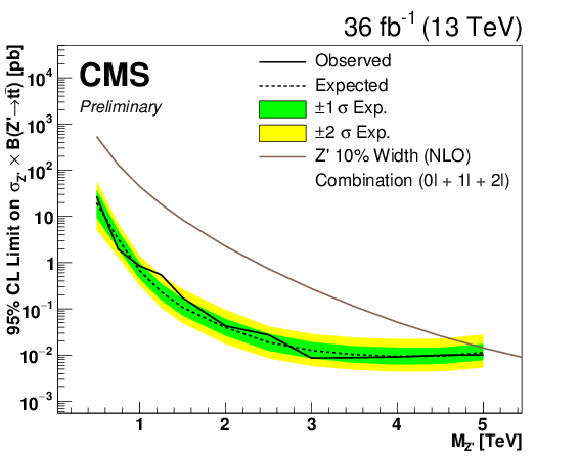
png pdf |
Figure 13-b:
Observed and expected limits for each of the four signal hypotheses considered in this analysis. |

png pdf |
Figure 13-c:
Observed and expected limits for each of the four signal hypotheses considered in this analysis. |
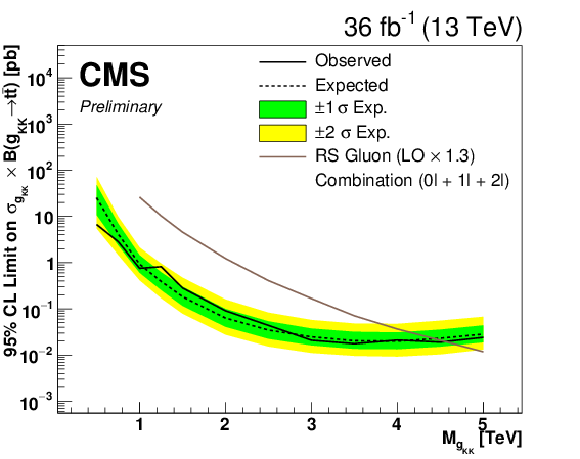
png pdf |
Figure 13-d:
Observed and expected limits for each of the four signal hypotheses considered in this analysis. |
| Tables | |
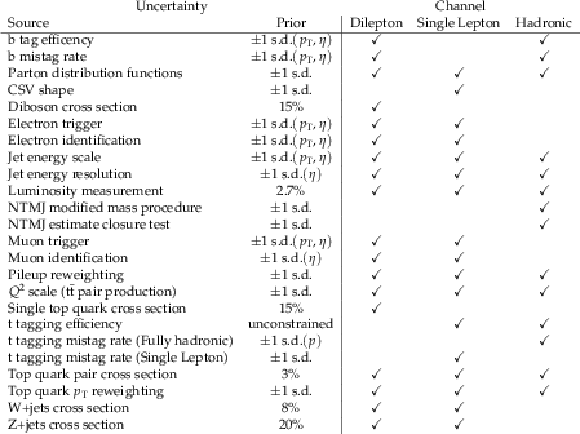
png pdf |
Table 1:
Sources of systematic uncertainty that affect the $ {M_{{{\mathrm {t}\overline {\mathrm {t}}}}}} $ distribution in each analysis channel. For uncertainty sources that apply to multiple channels, the corresponding nuisance parameter is fully correlated across these channels if the check symbol appears in the same row of the table. For normalization uncertainties, the size of the effect on the prior distribution is shown. Shape uncertainties have pirors of one standard deviation (s.d.), and the dependence on kinematic quantities is shown. |
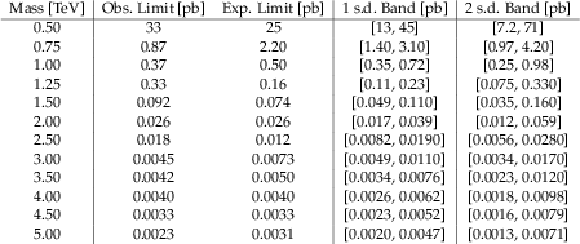
png pdf |
Table 2:
Limits on the product of the resonance production cross section times branching fraction, for the narrow (1%) width Z' boson resonance hypothesis. |

png pdf |
Table 3:
Limits on the product of the resonance production cross section times branching fraction, for the wide (10%) width Z' boson resonance hypothesis. |

png pdf |
Table 4:
Limits on the product of the resonance production cross section times branching fraction, for the extra-wide (30%) width Z' boson resonance hypothesis. |

png pdf |
Table 5:
Limits on the product of the resonance production cross section times branching fraction, for the $ {g_{\text {KK}}} $ gluon resonance hypothesis. |
| Summary |
|
A search for a generic massive $\mathrm{t\bar{t}}$ resonance has been presented. The analysis was performed on 36 fb$^{-1}$ of data collected by the CMS experiment in 2016 at the LHC with a $\sqrt{s} = $ 13 TeV. The analysis focused on searches for $\mathrm{t\bar{t}}$ resonances above 2 TeV, where the decay products of the top quark have become collimated due to a large Lorentz boost. The analysis performs an in-situ measurement of the analysis backgrounds and the t-tagging efficiency. The measure data are consistent with the background-only hypothesis, and no evidence for a massive $ \mathrm{t\bar{t}} $ resonance has been found. Since no signal was observed, limits at 95% CL are calculated for the production cross-section for a spin-1 resonance decaying to $ \mathrm{t\bar{t}} $ pairs with a variety of decay widths. Limits are calculated for two benchmark BSM processes that decay to $ \mathrm{t\bar{t}} $ pairs. The topcolor Z' boson with relative widths ($\Gamma/M$) of 1%, 10%, and 30% are excluded in the mass ranges 0.5-3.8, 0.5-5.0, and 0.5-5.0 TeV, respectively. KK excitations of the gluon in the Randall-Sundrum scenario are excluded between 0.5-4.55 TeV. This is the first search by CMS at $\sqrt{s} = $ 13 TeV for $ \mathrm{t\bar{t}} $ resonances that combines all three decay topologies of the $ \mathrm{t\bar{t}} $ system: dilepton, single lepton, and all hadronic. The sensitivity of the analysis exceeds previous searches at $\sqrt{s} = $ 8 and 13 TeV, particularly at high $ \mathrm{t\bar{t}} $ invariant mass. The absolution cross-section limits are 10-40% better, for $ {M_{\mathrm{t\bar{t}}}} $ above 2 TeV, than the previous result released by CMS scaled to 36 fb$^{-1}$. Previous measurements excluded the ${g_{\text{KK}}}$ up to 3.3 TeV and the topcolor Z' up to 2.5, 3.9, and 4.0 TeV for relative widths of 1%, 10%, and 30%, respectively. The presented analysis improves upon those limits, extending the ${g_{\text{KK}}}$ exclusion to 4.55 TeV and the Z' exclusions to 3.8, 5.0, and 5.0 TeV. These are the most stringent limits on the ${g_{\text{KK}}}$ and the topcolor Z' to date. |
| References | ||||
| 1 | CDF Collaboration | Observation of top quark production in $ \bar{p}p $ collisions | PRL 74 (1995) 2626 | hep-ex/9503002 |
| 2 | D0 Collaboration | Observation of the top quark | PRL 74 (1995) 2632 | hep-ex/9503003 |
| 3 | ATLAS Collaboration | Observation of a new particle in the search for the Standard Model Higgs boson with the ATLAS detector at the LHC | PLB 716 (2012) 1 | 1207.7214 |
| 4 | CMS Collaboration | Observation of a new boson at a mass of 125 GeV with the CMS experiment at the LHC | PLB 716 (2012) 30 | CMS-HIG-12-028 1207.7235 |
| 5 | CMS Collaboration | Observation of a new boson with mass near 125 GeV in pp collisions at $ \sqrt{s} = $ 7 and 8 TeV | JHEP 06 (2013) 081 | CMS-HIG-12-036 1303.4571 |
| 6 | ATLAS Collaboration | Measurement of the Higgs boson mass from the $ H\rightarrow \gamma\gamma $ and $ H \rightarrow ZZ^{*} \rightarrow 4\ell $ channels with the ATLAS detector using 25 fb$ ^{-1} $ of pp collision data | PRD 90 (2014) 052004 | 1406.3827 |
| 7 | CMS Collaboration | Precise determination of the mass of the Higgs boson and tests of compatibility of its couplings with the standard model predictions using proton collisions at 7 and 8 TeV | EPJC 75 (2015) 212 | CMS-HIG-14-009 1412.8662 |
| 8 | ATLAS, CMS Collaboration | Combined Measurement of the Higgs Boson Mass in pp Collisions at $ \sqrt{s}= $ 7 and 8 TeV with the ATLAS and CMS Experiments | PRL 114 (2015) 191803 | 1503.07589 |
| 9 | J. L. Rosner | Prominent decay modes of a leptophobic Z' | PLB 387 (1996) 113 | hep-ph/9607207 |
| 10 | K. R. Lynch, S. Mrenna, M. Narain, and E. H. Simmons | Finding $ Z' $ bosons coupled preferentially to the third family at CERN LEP and the Fermilab Tevatron | PRD 63 (2001) 035006 | hep-ph/0007286 |
| 11 | M. Carena, A. Daleo, B. A. Dobrescu, and T. M. P. Tait | $ Z' $ gauge bosons at the Fermilab Tevatron | PRD 70 (2004) 093009 | hep-ph/0408098 |
| 12 | D. Dicus, A. Stange, and S. Willenbrock | Higgs decay to top quarks at hadron colliders | PLB 333 (1994) 126 | hep-ph/9404359 |
| 13 | P. H. Frampton and S. L. Glashow | Chiral color: An alternative to the standard model | PLB 190 (1987) 157 | |
| 14 | D. Choudhurya, R. M. Godbole, R. K. Singh, and K. Wagh | Top production at the Tevatron/LHC and nonstandard, strongly interacting spin one particles | PLB 657 (2007) 69 | 0810.3635 |
| 15 | C. T. Hill | Topcolor: Top quark condensation in a gauge extension of the standard model | PLB 266 (1991) 419 | |
| 16 | C. T. Hill and S. J. Parke | Top production: Sensitivity to new physics | PRD 49 (1994) 4454 | hep-ph/9312324 |
| 17 | C. T. Hill | Topcolor assisted technicolor | PLB 345 (1995) 483 | hep-ph/9911288 |
| 18 | R. M. Harris and S. Jain | Cross sections for leptophobic topcolor Z' decaying to top-antitop | EPJC 72 (2012) 2072 | 1112.4928 |
| 19 | L. Randall and R. Sundrum | A large mass hierarchy from a small extra dimension | PRL 83 (1999) 3370 | hep-ph/9905221 |
| 20 | K. Agashe et al. | LHC signals from warped extra dimensions | PRD 77 (2008) 015003 | hep-ph/0612015 |
| 21 | H. Davoudiasl, J. L. Hewett, and T. G. Rizzo | Phenomenology of the Randall-Sundrum Gauge Hierarchy Model | PRL 84 (2000) 2080 | hep-ph/9909255 |
| 22 | CDF Collaboration | Limits on the production of narrow $ \mathrm{t\bar{t}} $ resonances in $ \text{p}\bar{\text{p}} $ collisions at $ \sqrt{s} = $ 1.96 TeV | PRD 77 (2008) 051102 | 0710.5335 |
| 23 | CDF Collaboration | Search for resonant $ t\bar{t} $ production in $ p\bar{p} $ collisions at $ \sqrt{s} = $ 1.96 TeV | PRL 100 (2008) 231801 | 0709.0705 |
| 24 | CDF Collaboration | A search for resonant production of $ t\bar{t} $ pairs in 4.8$ fb$^{-1} of integrated luminosity of $ p\bar{p} $ collisions at $ \sqrt{s} = $ 1.96 TeV | PRD 84 (2011) 072004 | 1107.5063 |
| 25 | D0 Collaboration | Search for a narrow $ t\bar{t} $ resonance in $ p\bar{p} $ collisions at $ \sqrt{s} = $ 1.96 TeV | PRD 85 (2012) 051101 | 1111.1271 |
| 26 | CDF Collaboration | Search for resonant production of $ t\bar{t} $ decaying to jets in $ p\bar{p} $ collisions at $ \sqrt{s} = $ 1.96 TeV | PRD 84 (2011) 072003 | 1108.4755 |
| 27 | D0 Collaboration | Search for $ t\bar{t} $ resonances in the lepton plus jets final state in $ p\bar{p} $ collisions at $ \sqrt{s} = $ 1.96 TeV | PLB 668 (2008) 98 | 0804.3664 |
| 28 | CMS Collaboration | Search for anomalous $ \mathrm{t\bar{t}} $ production in the highly-boosted all-hadronic final state | JHEP 09 (2012) 029 | CMS-EXO-11-006 1204.2488 |
| 29 | ATLAS Collaboration | A search for $ t\overline{t} $ resonances in lepton+jets events with highly boosted top quarks collected in $ pp $ collisions at $ \sqrt{s} = $ ~7~TeV with the ATLAS detector | JHEP 09 (2012) 041 | 1207.2409 |
| 30 | ATLAS Collaboration | Search for $ t\overline{t} $ resonances in the lepton plus jets final state with atlas using 4.7~fb$ ^{-1} $ of $ pp $ collisions at $ \sqrt{s} = $ 7~TeV | PRD 88 (2013) 012004 | 1305.2756 |
| 31 | CMS Collaboration | Search for resonant $ \mathrm{t\bar{t}} $ production in lepton+jets events in pp collisions at $ \sqrt{s} = $ 7 TeV | JHEP 12 (2012) 015 | CMS-TOP-12-017 1209.4397 |
| 32 | CMS Collaboration | Search for $ \mathrm{Z'} $ resonances decaying to $ \mathrm{t\bar{t}} $ in dilepton+jets final states in pp collisions at $ \sqrt{s} = $ 7 TeV | PRD 87 (2013) 072002 | CMS-TOP-11-010 1211.3338 |
| 33 | CMS Collaboration | Searches for new physics using the $ \text{t}\bar{\text{t}} $ invariant mass distribution in pp collisions at $ \sqrt{s} = $ 8~TeV | PRL 111 (2013) 211804 | CMS-B2G-13-001 1309.2030 |
| 34 | ATLAS Collaboration | Search for heavy particles decaying into top-quark pairs using lepton-plus-jets events in proton--proton collisions at $ \sqrt{s} = $ 13 TeV with the ATLAS detector | Submitted to: EPJ(2018) | 1804.10823 |
| 35 | CMS Collaboration | The CMS experiment at the CERN LHC | JINST 3 (2008) S08004 | CMS-00-001 |
| 36 | CMS Collaboration | Particle-flow reconstruction and global event description with the CMS detector | JINST 12 (2017) P10003 | CMS-PRF-14-001 1706.04965 |
| 37 | CMS Collaboration | Description and performance of track and primary-vertex reconstruction with the CMS tracker | JINST 9 (2014) P10009 | CMS-TRK-11-001 1405.6569 |
| 38 | M. Cacciari, G. P. Salam, and G. Soyez | The anti-$ k_t $ jet clustering algorithm | JHEP 04 (2008) 063 | 0802.1189 |
| 39 | M. Cacciari, G. P. Salam, and G. Soyez | FastJet user manual | EPJC 72 (2012) 1896 | 1111.6097 |
| 40 | CMS Collaboration | Performance of Electron Reconstruction and Selection with the CMS Detector in Proton-Proton Collisions at $ \sqrt{s}= $ 8 TeV | JINST 10 (2015) P06005 | CMS-EGM-13-001 1502.02701 |
| 41 | CMS Collaboration | Energy Calibration and Resolution of the CMS Electromagnetic Calorimeter in $ pp $ Collisions at $ \sqrt{s} = $ 7 TeV | JINST 8 (2013) P09009 | CMS-EGM-11-001 1306.2016 |
| 42 | CMS Collaboration | Determination of jet energy calibration and transverse momentum resolution in CMS | JINST 6 (2011) P11002 | CMS-JME-10-011 1107.4277 |
| 43 | M. Cacciari, G. P. Salam, and G. Soyez | The catchment area of jets | JHEP 04 (2008) 005 | 0802.1188 |
| 44 | CMS Collaboration | Top Tagging with New Approaches | CMS-PAS-JME-15-002 | CMS-PAS-JME-15-002 |
| 45 | CMS Collaboration | Identification of heavy-flavour jets with the CMS detector in pp collisions at 13 TeV | JINST 13 (2018) P05011 | CMS-BTV-16-002 1712.07158 |
| 46 | CMS Collaboration | Jet Performance in pp Collisions at 7 TeV | CMS-PAS-JME-10-003 | |
| 47 | CMS Collaboration | Missing transverse energy performance of the CMS detector | JINST 6 (2011) P09001 | CMS-JME-10-009 1106.5048 |
| 48 | CMS Collaboration | A Cambridge-Aachen (C-A) Based Jet Algorithm For Boosted Top-Jet Tagging | CDS | |
| 49 | CMS Collaboration | Boosted Top Jet Tagging at CMS | CMS-PAS-JME-13-007 | CMS-PAS-JME-13-007 |
| 50 | D. E. Kaplan, K. Rehermann, M. D. Schwartz, and B. Tweedie | Top Tagging: A Method for Identifying Boosted Hadronically Decaying Top Quarks | PRL 101 (2008) 142001 | 0806.0848 |
| 51 | D. Bertolini, P. Harris, M. Low, and N. Tran | Pileup Per Particle Identification | JHEP 10 (2014) 059 | 1407.6013 |
| 52 | A. J. Larkoski, S. Marzani, G. Soyez, and J. Thaler | Soft Drop | JHEP 05 (2014) 146 | 1402.2657 |
| 53 | J. Thaler and K. Van Tilburg | Identifying boosted objects with $ N $-subjettiness | JHEP 03 (2011) 015 | 1011.2268 |
| 54 | J. Thaler and K. Van Tilburg | Maximizing boosted top identification by minimizing $ N $-subjettiness | JHEP 02 (2012) 093 | 1108.2701 |
| 55 | J. Alwall et al. | The automated computation of tree-level and next-to-leading order differential cross sections, and their matching to parton shower simulations | JHEP 07 (2014) 079 | 1405.0301 |
| 56 | J. Alwall et al. | Comparative study of various algorithms for the merging of parton showers and matrix elements in hadronic collisions | EPJC 53 (2008) 473 | 0706.2569 |
| 57 | T. Sjostrand, S. Mrenna, and P. Z. Skands | A Brief Introduction to PYTHIA 8.1 | CPC 178 (2008) 852 | 0710.3820 |
| 58 | S. Ask et al. | Identifying the colour of TeV-scale resonances | JHEP 01 (2012) 018 | 1108.2396 |
| 59 | P. Nason | A new method for combining NLO QCD with shower Monte Carlo algorithms | JHEP 11 (2004) 040 | hep-ph/0409146 |
| 60 | S. Frixione, P. Nason, and G. Ridolfi | A positive-weight next-to-leading-order Monte Carlo for heavy flavour hadroproduction | JHEP 09 (2007) 126 | 0707.3088 |
| 61 | S. Alioli, P. Nason, C. Oleari, and E. Re | A general framework for implementing NLO calculations in shower Monte Carlo programs: the POWHEG BOX | JHEP 06 (2010) 043 | 1002.2581 |
| 62 | S. Alioli, P. Nason, C. Oleari, and E. Re | NLO single-top production matched with shower in POWHEG: s- and t-channel contributions | JHEP 09 (2009) 111 | 0907.4076 |
| 63 | E. Re | Single-top Wt-channel production matched with parton showers using the POWHEG method | EPJC 71 (2011) 1547 | 1009.2450 |
| 64 | R. Frederix and S. Frixione | Merging meets matching in MC@NLO | JHEP 12 (2012) 061 | 1209.6215 |
| 65 | GEANT4 Collaboration | $ GEANT4--a $ simulation toolkit | NIMA 506 (2003) 250 | |
| 66 | M. Hildreth, V. N. Ivanchenko, D. J. Lange, and M. J. Kortelainen | CMS Full Simulation for Run-2 | J. Phys. Conf. Ser. 664 (2015) 072022 | |
| 67 | B. P. Roe et al. | Boosted decision trees, an alternative to artificial neural networks | NIMA 543 (2005) 577 | physics/0408124 |
| 68 | A. Hocker et al. | TMVA - Toolkit for Multivariate Data Analysis | PoS ACAT (2007) 040 | physics/0703039 |
| 69 | NNPDF Collaboration | Parton distributions for the LHC Run II | JHEP 04 (2015) 040 | 1410.8849 |
| 70 | J. Butterworth et al. | PDF4LHC recommendations for LHC Run II | JPG 43 (2016) 023001 | 1510.03865 |
| 71 | CMS Collaboration | Measurement of the integrated and differential $ \mathrm{t\bar{t}} $ production cross sections for high-$ p_t $ top quarks in $ pp $ collisions at $ \sqrt{s} = $ 8 TeV | PRD 94 (2016) 072002 | CMS-TOP-14-012 1605.00116 |
| 72 | ATLAS Collaboration | Measurement of the differential cross-section of highly boosted top quarks as a function of their transverse momentum in $ \sqrt{s} = $ 8 TeV proton-proton collisions using the ATLAS detector | PRD 93 (2016) 032009 | 1510.03818 |
| 73 | T. Muller, J. Ott, and J. Wagner-Kuhr | theta - a framework for template-based modeling and inference | link | |
| 74 | R. J. Barlow and C. Beeston | Fitting using finite Monte Carlo samples | CPC 77 (1993) 219 | |

|
Compact Muon Solenoid LHC, CERN |

|

|

|

|

|

|